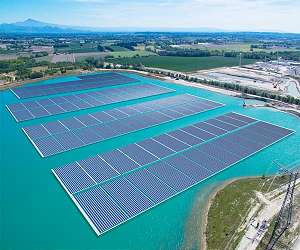Two-dimensional covalent organic frameworks (2D COFs) are a new class of organic semiconductors, and have recently demonstrated great potential for solar fuel production. They are generally formed from the ordered p-p stacking of molecular layers, and usually possess periodic columnar p-arrays that can facilitate the interlayer charge transfer. Furthermore, the ordered assembly of organic building units in 2D COFs also gives rise to one-dimensional (1D) micro- /meso-channels that can promote mass transport and expose reactive sites.
In spite of great structural advantages, 2D COFs usually suffer from low activities relative to their inorganic competitors. This is mainly due to the large binding energy of the photoexcitons in organic matters and consequently problematic exciton dissociation. In addtion, the hydrophobic nature of their p-conjugated aromatic backbones often cause their large inner porosity inaccessible to water. To fulfil the full potential of 2D COFs, synthetic and structural modifications are thereby desired to promote their structural crystallinity and water wettablity.
Recently, Professor Yanguang Li from Soochow University and collaborators reported a benzobisthiazole-based covalent organic framework (COF-BBT). The catalyst exhibited an excellent photocatalytic hydrogen evolution rate as high as 48.7 mmol h-1 g-1 in the presence of ascorbic acid as the sacrifical electron donor-among the highest values ever reported for COF-based photocatalysts. It was found that the benzobisthiazole (BBT) units played a profound effect on its electronic property and catalytic performance.
On the one hand, the BBT groups had rigid planar molecular configurations, and were believed to promote structural crystallinity via p-p interactions between individual aromatic blocks. Such an ordered stacking of p-units not only enhanced electrons delocalization between layers, but also provided necessary channels for the migration of photogenerated charges to the surface.
This hypothesis was validated by a series of spectroscopic measurements. Transmission electron microscopy (TEM) analysis first corroborated the high structural crystallinity of COF-BBT. Its 1D mesoporous channels and their hexagonal arrangement could be clearly observed. Photophysical analysis showed that crystalline COF-BBT had a weaker fluorescence emission and a longer excited state lifetime compared to the amorphous counterpart with the same chemical structure, indicating that the charge recombination was suppressed in COF-BBT.
On the other hand, BBT was an aromatic heterocycle rich in nitrogen and sulfur (> 50 wt%). The introduction of BBT units would lead to the increase structural polarity and thereby enhance water affinity of COF-BBT. This was confirmed by its much smaller water contact angle (21 ) and larger water vapor absorption capacity when compared with one sample without any heteroatoms. Both the increased crystallinity and water wettability collectively contributed to the excellent photocatalytic performance of COF-BBT.
For practical applications, the authors demonstrated that COF-BBT could directly grow on macroporous melamine foams by in-situ polymerization. The obtained composite not only enabled the stable hydrogen production, but also could be simply retrieved by taking out the foam from the solution. Furthermore, the authors also demonstrated that photocatalytic hydrogen production could be coupled with the oxidation of furfuryl alcohol to 2-furaldehyde at stoichiometry.
Research Report:Highly crystalline and water-wettable benzobisthiazole-based covalent organic frameworks for enhanced photocatalytic hydrogen production
Related Links
Institute of Functional Nano and Soft Materials, Soochow University
All About Solar Energy at SolarDaily.com
|
We need your help. The SpaceDaily news network continues to grow but revenues have never been harder to maintain. With the rise of Ad Blockers, and Facebook – our traditional revenue sources via quality network advertising continues to decline. And unlike so many other news sites, we don’t have a paywall – with those annoying usernames and passwords. Our news coverage takes time and effort to publish 365 days a year. If you find our news sites informative and useful then please consider becoming a regular supporter or for now make a one off contribution. |
||
|
SpaceDaily Contributor $5 Billed Once credit card or paypal |
SpaceDaily Monthly Supporter $5 Billed Monthly paypal only |
|

![]()
France exits fossil fuel treaty to boost renewables drive
Brussels (AFP) Oct 21, 2022
France is pulling out of a 1994 treaty that had the effect of protecting investment in fossil fuels when Europe is retooling towards a greener future, President Emmanuel Macron announced Friday.
“France has decided to withdraw from the Energy Charter Treaty,” he told a news conference in Brussels after an EU summit, two days after the Netherlands made a similar announcement.
The move was done to be more “coherent” with the Paris climate accord to combat global warming by relying more heavily on … read more
